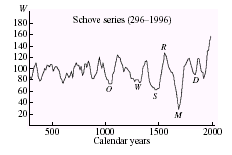 The aim of the present work is to analyze and predict the long-period variations in solar activity in the current century.
The aim of the present work is to analyze and predict the long-period variations in solar activity in the current century.Geomagnetism and Aeronomy, Vol. 43, No. 5, 2003, pp. 553–561. Translated from Geomagnetizm i Aeronomiya, Vol. 43, No. 5, 2003, pp. 592–601.
Original Russian Text Copyright © 2003 by Komitov, Kaftan.
English Translation Copyright © 2003 by
MAIK “Nauka
/Interperiodica” (Russia).Solar Activity Variations for the Last Millennia.
Will the Next Long-Period Solar Minimum be Formed?
B. P. Komitov* and V. I. Kaftan**
*Institute of Astronomy, Bulgarian Academy of Sciences, Stara Zagora, Bulgaria
**Central Research Institute of Geodesy, Aerial Photography, and Cartography,
Russian Federation Committee on Cartography, Moscow, Russia
Received August 21, 2002; in final form, March 1, 2003
Abstract
—The series of macrocharacteristics of the 11-year Schwabe–Wolf cycles (the so-called Schowe series) has been used to specify notions of the character of long-term variations in solar activity. A mathematical statistic analysis of data in the series has been performed using two independent methods. Statistically significant cyclic oscillations with periods of about 100, 122, 205, 350, and 1200 years have been revealed. About 200-year cycle, which was unnoticeable in the relatively short 250-year series of the most reliable instrumental data (since it was reduced by other long-period oscillations), proved to be the most powerful among these oscillations. An analysis of obtained results has indicated that it is highly probable that the next long-period minimum of solar activity, which will possibly be not so deep as the Maunder and Sperer minimums, will be formed in the 21st century.
1. INTRODUCTION
An analysis of the time series of the main indices of sunspot activity indicates that, in the second half of the 20th century, they have reached extremely high levels for the last 400 years. Published data on the behavior of the group sunspot number [Hoyt and Schatten, 1998] and data of the classical Zurich series [Waldmeier, 1961] make it possible to affirm that this state is caused by the long-term ascending tendency of variation in solar activity, which began from approximately 1700, at the end of the so-called Maunder Minimum. This tendency is expressed first of all in increased amplitudes of the 11-year Schwabe–Wolf solar cycles. The prolonged increase in solar activity after 1700 was terminated twice: at the beginning of the 19th (theDalton Minimum) and 20th centuries.
These minimums are the consequences of the secular and 200-year cycles.The situation considered above is corroborated independently and by analyzing data on the so-called cosmogenic radioisotopes (mainly 14 C and 10Be) [Stuiver and Quay, 1980; Dergachev and Chistyakov, 1990; Beer et al. , 1998].
The rule of even–odd pairs of the 11-year solar cycles or the Gnevyshev–Ohl rule [Gnevyshev and Ohl, 1948] is one of the most important features of the time series of instrumental data on sunspot activity. According to this rule, even cycles are usually weaker than the following odd cycles. For the last 250 years, this role has been violated only twice: for the pairs of cycles 4–5 and 8–9. Analyses of the Rg index for the epoch before 1749, as well as of the time series of indirect data on solar activity, such as the Schove series [Schove, 1955], indicate that in the previous epochs these violations were more frequent than in the period covered by the Zurich series.
Two questions arise. What is the origin of this ascending long-period tendency in the behavior of solar activity? Will this tendency continue in the 21st century or be interrupted for some reason?
At the end of the 20th century, the concept dominated that the long-period rise in the level of solar activity will continue in the following century. Specifically, by 1997 researcher considerably more often predicted in the scientific literature that the power of the 11-year cycle 23 will be approximately equal or higher than that of cycle 22. One of the arguments used by adherents ofthe scenario of powerful cycle 23 was also the Gnevyshev –Ohl rule, from which it followed that cycle 23 will be more powerful than cycle 22.
The reality proved to be absolutely different. The current cycle (cycle 23) is substantially weaker than cycle 22. According to the preliminary estimations, the average annual maximal Wolf number of cycle 23 is about 120, whereas this index for cycle 22 is equal to 157. The violation of the Gnevyshev–Ohl rule for pair 22–23 of the solar cycles is not only evident but also very considerable. Such a situation has been observed for the first time for the last 150 years. Moreover, it turns out that the total solar magnetic flux in the current cycle is approximately twice weaker than in the previous three cycles (cycles 20–22), when this index was approximately identical [de Toma et al. , 2000].
 The aim of the present work is to analyze and predict the long-period variations in solar activity in the current century.
The aim of the present work is to analyze and predict the long-period variations in solar activity in the current century.
Fig. 1.
The Schowe series (296–1996); smoothed data. Letters denote the Oort, Wolf, Sperer, Maunder, and Dalton minimums and the Renaissance maximum in the 16th century. All powers correspond to the centers of the smoothing periods.
2. RESULTS OF OBSERVATIONS
Unfortunately, the possibilities of using instrumental data for estimating long-period tendencies in solar activity are too limited. For example, the Gleissberg near-secular cycle manifested itself in the Zurich series of the Wolf numbers and in the Hoyt–Schatten series (Rg index) only about three and four times, respectively. These circumstances lead to the necessity of analyzing longer series of indirect data on solar activity. At present, researchers most often use the series of the rate of production and accumulation of the so-called cosmogenic isotopes (
14 C and 10 Be). However, an analysis of the causes of interrelation between changes in 14C and solar activity results in the assumption of a considerable phase delay of measured concentrations of thisisotope in different Earth’s media (tree rings, stalactites, etc.) relative to the levels of corresponding changes on the Sun. Beryllium data, obtained as a result of analyzing ice samples in Greenland, are presented as an insufficiently long series started in 1423 [Beer et al. , 1998].The indicated facts substantially limit the set of applicable series of indirect indices of solar activity. It turns out that essentially only one, relatively old, series (known as the Schove series) satisfactorily meets the formulated requirements. This series was compiled in the late 1940s–early 1950s by a British scientist Derek Schove [Schove, 1955]. It represents the set of macrocharacteristics of the Schwabe–Wolf 11-year cycles (years of minimums and maximums and a power) for the last 2600 years. The series was compiled based on the historical records of observations of auroras, visible sunspots, extreme meteorological phenomena, bright comets, annual tree rings, etc. A power is characterized by the nine-power scale related to average annual Wolf numbers for each cycle. For the cycles of the epoch of instrumental observations, a power is determined according to the Zurich series data. The years of extremums of the 11-year cycles in the Schove series have been determinedapproximately. Uncertainties in determining
the instants of extremums reach 2–3 years before the 15th century and are not more than 1 year for the 16th century and the later periods.
The Schove series is continuous beginning from 296 AD. Earlier information is absent; therefore, in the present work we use only the continuous part, which begins from the end of the 3d century AD. The smoothed power series of the Schwabe–Wolf cycles is shown in Fig. 1. In the late 1970s, the Schove series was subject to criticism [Eddy, 1977]. The criticism was largely based on obtained results of analyzing the characteristics of cosmogenic radiocarbon (
14C), which caused Schove [1983] to make certain corrections concerning the levels of solar activity during the Maunder Minimum toward their decrease relative to his first version. However, Komitov [1997] indicated that substantial differences are actually absent between the radiocarbon series of annual tree rings (measurements of 10-year ring blocks) and the Schove series. Komitov [1999] presented additional arguments for good agreement between the radiocarbon data and the Schove series.The new evidence that it is possible to use the Schove series as a source of information about the level of solar activity will be presented in the last section of this paper. After a decrease in the interest in the above data in the1990s, the Schove series has attracted attention of researchers again [Komitov, 1997, 1999; Fyodorov et al. , 1996; Rivin, 1993; Romanov and Zgonyaiko, 1994].
3. ANALYSIS OF OBSERVATIONS
To reveal cycles in data of the Schove time series, we have used a T–R periodogram analysis described in detail by Komitov [1986, 1997, 2001] and Bonev [2001]. First, we smoothed data over five points (Schwabe–Wolf cycles) in order to more reliably distinguish lowfrequency cycles in the Schove series. As a time unit we used the average length of the Schwabe–Wolf cycle (labeled by Sc ), as it was done in [Komitov, 1997]. This unit is also the time step of the Schove series. In this case the range of possible cycles is
2 Sc- T 152 Sc . The lower limit corresponds to the Nyquist frequency, and the upper limit is approximately equal to the length of the time series (151 Sc).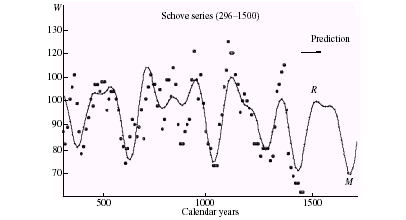
Fig. 2.
The Schove smoothed series (296–1500) and a model taking into account the cycles of duration 11, 19, 33, and 122 Sc R and M are the predicted Renaissance Maximum and Maunder Minimum.
The final stage of a periodogram analysis was the construction of a regression model of the form
Where m is the number of statistically significant cycles included in a model, whose maximal value can be equal to the total number of statistically significant cycles determined by a T–R analysis; A
0 is the average value of an observed quantity; and periods Tj correspond to a duration of cycles and have also been determined from an obtained T–R correllogram. Instant t correspond to ordinal numbers of data powers of the time series, i.e., to 0, 1,2…N-1, N Coefficients Aj and Bj are determined by the least squares method. The obtained function(t), approximating the time series, can be characterized by the same parameters as are used to characterize any regression function, i.e., by the correlation coefficient R , variance, Fisher–Snedekor parameter (F-parameter), etc. This function can be used for prediction by specifying t values exceeding a final instant of the time series.We performed a control experiment in order to demonstrate the possibilities of using time series models described by functions of type (1). In so doing, we assumed that the Schove series has been terminated in 1500 rather than in 1996, as it takes place at present. In such a case, it becomes possible to reveal statistically significant cycles on the interval 296–1500. The control experiment consisted of the following procedures. Regression model (1) was constructed based on revealed cycles. Then, we extrapolated an obtained model to the future (e.g., for 200–300 years ahead) and verified the degree of its correspondence to the actual behavior of solar activity. We assumed that a model operates well on a specified prediction interval, if a prediction reflects such substantial events in the longperiod variations in solar activity that took place after 1500 (e.g., the Renaissance Maximum in the 16th century and the Maunder Minimum in the 17th century).
Using a T–R periodogram analysis, we established that in 296–1500 we can reliably reveal four oscillations lasting for 11, 19, 33, and 122 Sc or, correspondingly, for 122, 209, 360, and 1300 years. The 209-year oscillation is the most powerful among them. This result does not contradict results of analyzing indirect data on solar activity obtained by the present. A model with the participation of the above cycles is presented in Fig. 2. The correlation coefficient between factual data and model calculations is 0.77. A model has been extrapolated to 1760. A comparison with Fig. 1 indicates that the predicted times of the Maunder Minimum and the Renaissance Maximum are in a rather close agreement with actual values. Specifically, the onset of the deepest phase of the Maunder Minimum is referred to 1690, which took place in reality. On the other hand, we have obtained a certain difference between the factual and predicted oscillation amplitudes. A factual increase related to the Renaissance Maximum was stronger than the predicted increase. At the same time, the predicted Maunder Minimum is not so deep as the actual minimum presented in the Schove series.
Taking into account the last remarks, we can assume that results of the control experiment are satisfactory,which makes it possible to use a T–R periodogram analysis to reveal hidden periodicities and to predict macrocharacteristics of solar activity. Differences between actual and predicted amplitudes will be explained below.
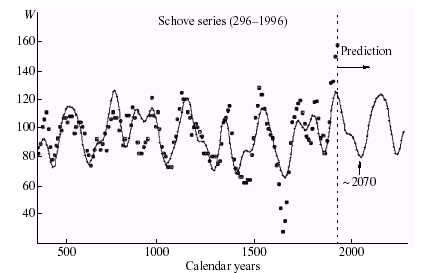 Fig. 3.
Fig. 3.
A model of the Schove series (296–1996): moving averaging for five maximums of the Schwabe–Wolf cycles.
The next stage of the studies was to construct a model of large-scale secular oscillations of solar activity based on the continuous part of the Schove series smoothed over five points (maximums of the Schwabe–Wolf cycle). In this case, a T–R periodogram analysis made it possible to reveal statistically significant oscillations with periods of 9, 11, 18.5, 32, and 111Sc (100, 122, 205, 353, and 1220 years, respectively).
A model constructed for the above cycles is presented in Fig. 3. The model extrapolation to the 21st–22nd centuries indicates that present-day solar activity is in the epoch of a “bend” at the very beginning of the prolonged moderately deep long-period decline. The obtained correlation coefficient between data and model is equal to 0.78.
An analysis indicates that the contribution of the 200-year cycle is the main factor in this situation. If we construct a model based only on this cycle, a correlation coefficient of 0.59 will fall on the boundary of regression (prognostic) significance. This 200-year cycle is shown in Fig. 4a. Nearly 400- and 1000-year cycles are considerably less pronounced than the 200- year cycle (Figs. 4b, 4c). Figure 4 indicates that the forthcoming secular minimum is first of all related to the impending minimum of the 200-year cycle, which can take place about 2061. According to the model, the last maximum of this cycle was in 1956 and almost coincides with the maximum of the powerful Zurich cycle (cycle 19). The last minimum of the 205-year cycle took place about 1850, i.e., immediately after the Zurich cycle 9.
The last rise of solar activity in the 360-year cycle (Fig. 4b) began in the first half of the 18th century and reached its maximum by the beginning of the 20th century. During the last century, this cycle was at a relatively high phase but will make a considerable additional contribution to the forthcoming long-period minimum during the following 100 years, approaching to its own minimum.
According to the model, the last minimum of the 1000-year cycle began almost simultaneously with the Sperer Minimum in the 15th century. In the recent epoch, it has manifested itself in the almost maximal phase; however, according to the model, its absolute maximum will be in the first half of the 21st century. Its role consists in reducing a depth of the predicted longperiod minimum.
Models presented in Fig. 4 make it possible to assume that the Maunder Minimum was at nearly minimal phases of the 350- and 1200-year cycles and almost coincided with the minimum of the 205-year cycle. On the contrary, these three cycles were near their maximal phases in the second half of the 20th century. At the same time, a model presented in Fig. 3 indicates that, at least qualitatively, the Maunder Minimum can be explained by the superposition of the minimums, whereas the high level of solar activity at the end of the 20th century can be explained by the superposition of the maximums of the 205-, 360-, and 1200-year cycles. Nevertheless, this cannot adequately explain why these two long-period extremums are so pronounced, which can mean that some factor remains omitted in the model. Further we will indicate that this is a probable effect of the very powerful nearly 2000-year solar cycle.
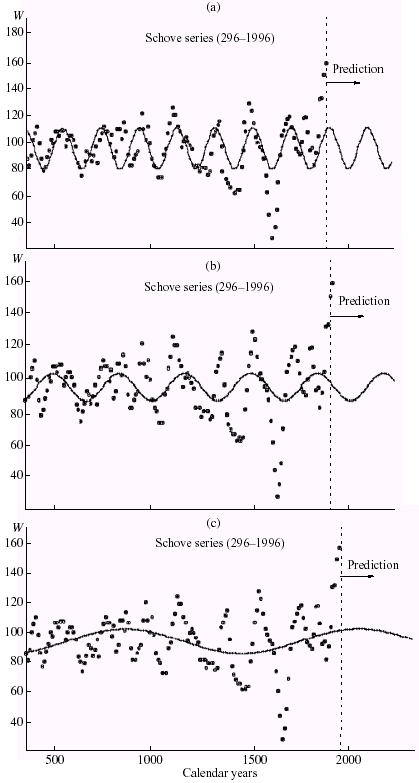 Fig. 4.
Fig. 4.
Models of (a) 200-year, (b) 360-year, and (c) 1200-year oscillations in the Schove series.
A sequential analysis of dominating harmonics, which was previously applied for determining fluctuations of the Caspian Sea level [Kaftan, 1994] and variations in solar activity (based on average monthly values of International indices Ri ) [Kaftan et al. , 2001], as well as for analyzing the series of absolute determinations of gravity and other natural processes [Kaftan, 2002], was used to additionally control the determination of the periodic components and to model solar activity based on the Schove series.
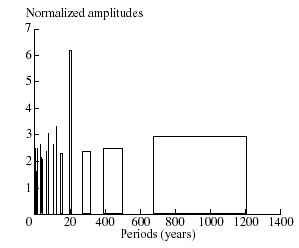
Fig. 5.
Distribution of the periodic components revealed in the Schove series using the technique of analyzing dominating harmonics (horizontal boundaries of histogram columns correspond to the T + 2mt values, where mt is the empirical standard of determining T).
As a result of analyzing the second half of the Schove series (from 1000 to the present), we have obtained the spectrum of the periodic components (Fig. 5) close to results of a T–R periodogram analysis. Results presented in Fig. 5 indicate that all most significant components agree well with results of a T–R periodogram analysis described above. At the same time, when analyzing the complete Schove series using this technique, we stop to reveal the statistically significant longest-period (nearly 1000- and 2000-year) components. Therefore, we should note that the applied technique uses unsmoothed data in contrast to a T–R periodogram analysis.
Figure 6 demonstrates a prediction model obtained from data of the last millenium using the method of analyzing dominating harmonics. This model also agrees well with the previous prediction but is more detailed since it uses a greater number of statistically significant harmonic components. Nevertheless, the main trend of solar activity also indicates that this activity will decrease in the nearest future.
The prediction based on analyzing dominating harmonic components with the help of the complete Schove series but without the nearly 1000- and 500- year components differs from the prediction presented in Fig. 5 in that the minimum expected at the end of the 21st century becomes deepest and approximates to the level of the Maunder Minimum.
Nevertheless, we have grounds to consider that the model obtained based on data of the last millennium is more effective, since it is based on more homogeneous and accurate data. Results of examining prediction models for the current solar cycle [Kaftan et al. , 2001; Demianov et al., 1999], which demonstrated a higher accuracy of the prediction made on the basis of more recent data on average monthly values of the Ri index in the second half of the 20th, lead to such a conclusion.
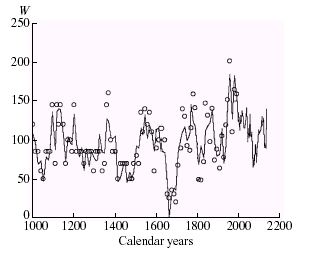 Fig. 6. Approximation of the Schove series (data for the last millennium) by the polyharmonic
Fig. 6. Approximation of the Schove series (data for the last millennium) by the polyharmonic
function and the prediction of solar activity maximums (solid line) based on analyzing dominating harmonics.
As was mentioned above, two main time series of solar activity characteristics have been obtained based on telescopic observations. The first of them (the Zurich series) was compiled in the 19th century by Wolf, who systematized observations of the solar disk, and was subsequently completed mostly by Waldmeier [1961]. The second time series was developed by Hoyt and Schatten [1998] based on the studies of the group sunspot numbers ( Rg ). The continuous Zurich series begins from 1749, and the Hoyt and Schatten series starts at 1610. The series of Rg indices is more representative since it has been created based on analyzing almost doubled volume of observations as compared to such a volume used to compile the Zurich series.
Results of a T–R periodogram analysis of the above series can be generated in the following way: 1. The 200-year cycle is insufficiently pronounced in the Zurich series. In addition to the strongest 11-year cycle, the 100-, 53-, and 64-year oscillations are also observed in this series. The oscillation with a period of about 41 year is distinguished at the boundary of statistical significance. A nearly periodic trend, corresponding to the cycle lasting for about 290 years, is also distinguished. However, since the period of this cycle exceeds the length of the Zurich series, it hardly can be determined reliably (see also [Bonev, 1997]).
A model constructed based on the above nearly periodic components predicts that the series of 11-year cycles will be relatively weak beginning with cycle 23. According to this model, a long-period solar minimum should begin about 2012. The cycles with periods of 11, 38–40, 54, 62, 118, and 192 years are found out in the Hoyt–Schatten series using a T–R periodogram analysis. In contrast to the Zurich series, the 200-year oscillation is not only present in this series but is weaker only than the Schwabe–Wolf 11-year cycle.
Figure 7 shows a model of large-scale variations in the Rg index constructed based on summing nearly periodic components with periods longer than 30 years. For the 21st century, this model demonstrates a result close to the result of analyzing the Schove series, namely: the beginning of a clearly defined long-period minimum, which is also related to a minimum of the 200-year cycle.
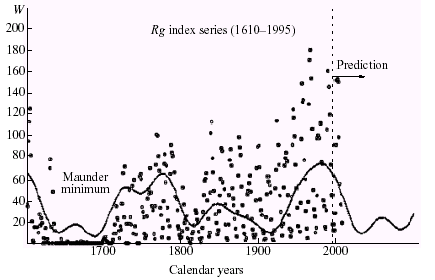
Fig. 7. The series of the average annual values of the Rg index and a model of its large-scale variations (1610–1995).
4. DISCUSSION AND CONCLUSIONS
Results of a performed analysis indicate that the 200-year cycle is present in all models, the extrapolation of which leads to the conclusion that a long-period solar minimum will begin in the 21st century. This holds true for the Schove and Hoyt–Schatten series, in contrast to which only a minimum related to the secular cycle is clearly defined in the extrapolation of the Zurich series. In this case we should note that the technique used by Kaftan et al. [2001] to analyze the Zurich series makes it possible to distinguish the 200-year component but on the statistically less significant level and with an amplitude substantially smaller than in the Schove series.
It is unclear why the nearly 200-year cycle clearly defined in the Schove, cosmogenic isotopes, and Hoyt– Schatten series is as a rule indistinguishable in the Zurich series.
The cause consists in that the Zurich series completely falls in the interval of the general long-period rise of solar activity, which began at the end of the Maunder Minimum. This circumstance suppresses the manifestation of the 200-year cycle. The Dalton Minimum, which started at the beginning of the 19th century, can be considered as a consequence of this longperiod tendency. The relative power of this minimum is insufficient for revealing it with the help of a T–R periodogram analysis. The origin of this long-period increase in solar activity cannot be explained even within the scope of the relatively long Schove series. All this holds true for the much deeper Maunder Minimum and can be explained by analyzing radiocarbon data. The powerful cycle lasting for 2200–2400 years, evidently related to the processes proceeding on the Sun, has been found out in these series. For the last 10 thousand years, this cycle has had four minimums, the last of which was the Maunder Minimum.
The structure of the nearly 2000-year cycle was studied by Dergachev and Chistyakov [1990]. A slightly modified kinematics of changes in this cycle is shown in Fig. 8, where an insignificant local minimum is distinguished after a plateau-shaped segment.
An analysis indicates that each nearly 2000-year cycle begins with a deep minimum of a Maunder type. Then, a steep ascent follows for 300–350 years and is replaced by a prolonged epoch with relatively imperceptible secular and 200-year oscillations, which has the character of a plateau. This state continues for 400– 500 years and is interrupted by a decline lasting for 300–400 years, during which the 200-year cycle becomes stronger. The new ascent follows afterwards (an absolute maximum of the nearly 2000-year cycle).
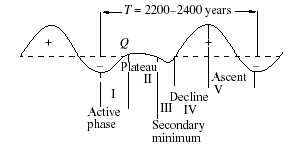
Fig. 8. Structure of the cycle lasting for 2200–2400 years. Symbol Q marks the position of the present-day epoch (2000).
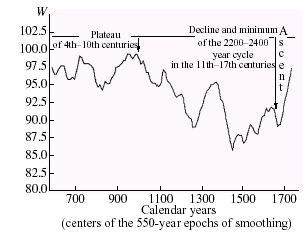
Fig. 9. The Schove series: data smoothed over 550 years and the main phases of the cycle lasting for 2200–2400 years.
Judging by certain characteristics, this ascent is a specific restoration of the plateau-shaped phase. The final phase continues for 600–700 years and terminates in a new minimum of a Maunder type. This phenomenon is accompanied by an enhancement of the 200-year cycle [Komitov, 1999]. The continuous part of the Schove series factually includes the greater part of the plateau, maximum and decline of the nearly 2000-year cycle, and initial ascent (active phase) of the current cycle (Fig. 9).
Figure 9 indicates that the present-day epoch corresponds to the end of the initial active phase of the nearly 2000-year cycle and changes (has perhaps already entered) into the plateau. Komitov and Bonev [2001] indicated that one should not assume that a long-period minimum in the 21st century will be so deep as the Sperer or Maunder minimums. This minimum can probably be so deep as, e.g., the Dalton Minimum because it will coincide with a relatively high plateau. Within the limits of the nearly 2000-year cycle, this minimum will probably be an analog of the minimums that took place before 1000.
The violation of the Gnevyshev–Ohl rule for the pair of cycles 22 and 23 should not be considered as any crisis in understanding of cyclic processes on the Sun. This rule was derived based on analyzing the Zurich series and is very significant at the active phase of the cycle lasting for 2200–2400 years. An analysis of the Schove series indicates that such violations of the rule are usual at the remaining phases of this cycle. The strongest violations, including the present-day one, take place before minimums of 200-year cycles [Komitov and Bonev, 2001].
It is quite possible that the onset of a long-period solar minimum can result in unexpected (from the present-day viewpoint) climatic changes, namely, in a global cooling. Damon and Sonett [1991] indicated that all minimums of the 200-year solar cycle are usually accompanied by a decrease in the average temperature of the Earth by about 1°C. If such a climatic scenario actually take place, this will be a forcible argument for a heliogeophysical theory of climate changes. Such a phenomenon would force out a theory of anthropogenic greenhouse effect in the background.
ACKNOWLEDGMENTS
This work was supported by the Russian Foundation
for Basic Research, project no. 02-05-46176.
REFERENCES
Beer, J., Tobias, S., and Weiss, N., An Active Sun throughout the Maunder Minimum, Solar Phys., 1998, vol. 181, no. 1, pp. 237–249.
Bonev, B., Estimating the Course of the Solar Activity at the End of 20th and Beginning of 21st Century on Time Variations within the Zurich Series, Bulg. Geophys. J., 1997, vol. 23, nos. 3/4, pp. 43–47.
Damon, P.E. and Sonett, C.P., Solar and Terrestrial Components of the Atmospheric 14C Variation Spectrum, The Sun in Time, Sonett, C.P. and Giampapa, M. S., Eds., Tucson: Arizona Univ. Press, 1991, pp. 360–387.
Demianov, G.V., Kaftan, V.I., and Zubinsky, V.I., Participation of the Central Research Institute of Geodesy, Aerial Surveying and Cartography, Third Baltic Sea Level GPS Campaign, Reports of the Finnish Geodetic Institute, Kirkkanummi, 1999, pp. 127–132.
Dergachev, V.A. and Chistyakov, F., 210- and 2400-Year Solar Cycles and Climate Changes, Izv. Fiz.–Tekh. Inst. Akad. Nauk SSSR, 1990, pp. 112–129.
De Toma, G., White, O.R., Chapman, G.A., Walton, S.R., Preminger, D., Coockson, A., and Harvey, K.L., The Sun’s Radioactive Output in Cycles 22 and 23, Atrophys. J., 2000, vol. 529, pp. 1101–1114.
Eddy, J.A., Historical Evidence for the Existence of the Solar Cycle, Solar Output and Its Variation, White, O.R., Ed., Boulder: Associated Univ. Press, 1997, pp. 51–71.
Fyodorov, M.V., Klimenko, V.V., and Dovgalyuk, V.V., Sunspot Minima Dates: A Secular Forecast, Solar Phys., 1996, vol. 165, pp. 193–199.
Hoyt, D. and Schatten, K., Group Sunspot Numbers: A New Solar Activity Reconstruction, Solar Phys., 1998, vol. 181, no. 2, pp. 491–512.
Gnevyshev, M. and Ohl, A., On the 22-Year Cycle of Solar Activity, Astron. J., 1948, vol. 38, pp. 18–20.
Kaftan, V.I., Oscillations of Sea Level and Vertical Movements of the Earth’s Surface in the Caspian Region, Napryazheniya v litosfere (global’nye, regional’nye, lokal’nye) (Stresses in the Lithosphere: Global, Regional, Local), Moscow: Inst. Geol. Razrab. Goryuchikh Iskopaemykh, 1994, p. 79.
Kaftan, V.I., Gravity Variation at the Moscow Fiducial Station, IAG, Frankfurt am Main, 2002, pp. 293–296.
Kaftan, V.I., Tatevyan, S.K., and Kasimenko, T.V., Periodicity Analysis and Long-Term Forecast of Changes in Solar Activity, Dopolneniya k materialam IV mezhdubarodnogo seminara “Fundamental’nye i prikladnye problemy monitoringa i prognoza stikhiinykh bedstvii” (Supplements, Proc. 4th Int. Seminar “Fundamental and Applied Problems of Monitoring and Forecasting Natural Disasters,” Sevastopol, 2001, pp. 1–16.
Komitov, B., On a Possible Effect of Solar Cycles on the Climate of Bulgaria, Solar Data, 1986, no. 5, pp.73–78.
Komitov, B., The Schove’s Series: Centurial and Supercenturial Variations of Solar Activity. Relationships between Adjacent Solar Cycles, Bulg. Geophys. J., 1997, vol. nos. 1-2, pp. 69–79.
Komitov, B., To Problems of Stability of the 100- and 200- Year Solar Cycles, Doklady 6 Natsional’noi konferentsii solneno-zemnoi fizike (Rep. 6th National Conf. on Sun–Earth Physics), Sofia, 1999, pp. 185–187.
Komitov, B., T–R Periodogram Analysis, Khronobiologiya I biometeorologiya v b”lgarskata meditsina (Chronobiology and Biometeorology in Bulgarian Medicine), Madzhirov, Ed., Plovdiv: 2001, pp. 30–31.
Komitov, B. and Bonev, B., Amplitude Variations of 11-Year Solar Cycles and the Current Solar Maximum 23, Astrophys. J. Lett., 2001, vol. 554, pp. L119–L122.
Rivin, Yu.R., Amplitudes of Changes in the Solar Magnetic Cycle for about 500 Years according to Direct and Indirect Data of Observing Spots, Izv. Fiz. Tekh. Inst., Ross. Akad. Nauk, 1993, pp. 82–93.
Romanov, Yu.S. and Zgonyaiko, N.S., The Periodicity Solar Activity Cycles, Solar Phys., 1994, vol. 152. pp. 31–
Schove, D.J., The Sunspot Cycle 649 BC to 2000 AD, J. Geophys. Res., 1955, vol. 60, pp. 127–146.
Schove, D.J., Sunspot Cycles, Stroudsburg: Hutchinson Ross, 1983.
Stuiver, M. and Quay, P.D., Changes in Atmospheric Carbon- 14 Attributed to a Variable Sun, Science, 1980, vol. 207, no. 14, pp. 26–30.
Waldmeier, M., The Sunspot Activity in Years 1610–1960, Zurich: Zurich Schultes Co., 1961.